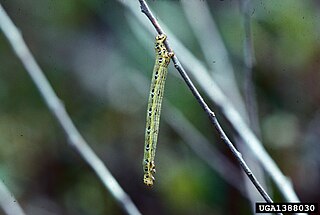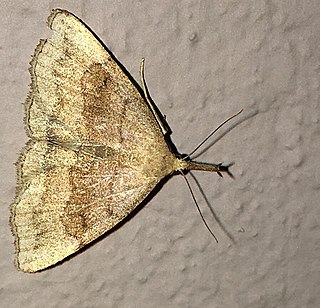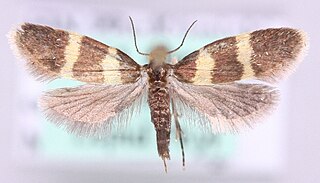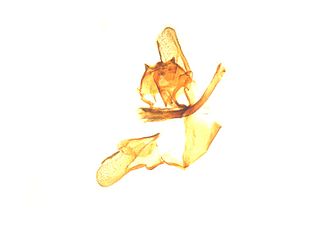The Prodoxidae are a family of moths, generally small in size and nondescript in appearance. They include species of moderate pest status, such as the currant shoot borer, and others of considerable ecological and evolutionary interest, such as various species of "yucca moths".

André Jean Baptiste Robineau-Desvoidy was a French physician and entomologist specialising in the study of Diptera (flies) and to some extent of the Coleoptera (beetles).

The Royal Alberta Museum (RAM) is a museum of human and natural history in Downtown Edmonton, Alberta, Canada, located north of City Hall. The museum is the largest in western Canada with more than 7,600 square metres (82,000 sq ft) exhibition space and 38,900 square metres (419,000 sq ft) in total.

Apamea sordens, the rustic shoulder-knot or bordered apamea, is a moth of the family Noctuidae. The species was first described by Johann Siegfried Hufnagel in 1766. It is distributed throughout Europe, east across the Palearctic to Central Asia and to China and Japan. It also occurs in North America.

The red-tailed chipmunk is a species of rodent in the family Sciuridae. It is found in Alberta and British Columbia in Canada and Montana, Idaho and Washington in the United States.

Caradrina morpheus, the mottled rustic, is a moth of the superfamily Noctuoidea. The species was first described by Johann Siegfried Hufnagel in 1766. It is found across the Palearctic from northern Europe to Siberia, Amur and Korea. Also in Armenia and Turkestan. It was accidentally introduced on both the east and west coasts of Canada and is so far reported in the east from New Brunswick to Ontario, and in the west from British Columbia.

Eriocrania semipurpurella is a moth of the family Eriocraniidae, found from Europe to Japan and in North America. It was first described by James Francis Stephens in 1835. The species closely resembles Eriocrania sangii and the larvae of both species mine the leaves of birch.

Cingilia is a monotypic moth genus in the family Geometridae erected by Francis Walker in 1862. Its only species, Cingilia catenaria, the chain-dotted geometer, chain dot geometer, chainspotted geometer or chain-spotted geometer, was first described by Dru Drury in 1773. It is found in North America from Nova Scotia south to Maryland and west to Kansas and Alberta.

Phalaenostola metonalis, the pale phalaenostola, tufted snout or pale epidelta, is a moth of the family Erebidae. The species was first described by Francis Walker in 1859. It is found in North America from British Columbia to Newfoundland, south to North Carolina, west to Missouri.

Lampronia corticella, the raspberry moth, is a moth of the family Prodoxidae. The species was first described by Carl Linnaeus in his 1758 10th edition of Systema Naturae. It is found in most of Europe, except Iceland, the Iberian Peninsula and the Balkan Peninsula. It is an introduced species in North America, where it was first detected in New Brunswick, Canada, in 1936.

The currant shoot borer moth is a species of moth of the family Prodoxidae. It is found in most of central, northern and eastern Europe. It is also found in North America.

Lampronia is a genus of moths of the family Prodoxidae.
Lampronia intermediella is a moth of the family Prodoxidae. It is found in Slovakia and Romania.

Lampronia redimitella is a moth of the family Prodoxidae. It is found in Fennoscandia, the Baltic region, Poland, the Czech Republic and Germany.

Lampronia pubicornis is a moth of the family Prodoxidae. It is found in Ireland, Great Britain, France, Spain, Germany, Austria, Hungary and on Sicily, in addition to Venice and occasionally mainland Italy.
Lampronia altaica is a moth of the family Prodoxidae. It is found in the Altai Mountains of central Asia, the Ryanggang Province of North Korea and in Japan.
Lampronia sublustris is a moth of the family Prodoxidae first described by Annette Frances Braun in 1925. In North America it is found from southern British Columbia south to northern California and east to Alberta, Utah and Colorado.
Metareva aenescens is a moth of the subfamily Arctiinae. It was described by George Hampson in 1900. It is found in Bolivia.

Pseudeustrotia carneola, the pink-barred lithacodia moth, is a moth of the family Noctuidae. The species was first described by Achille Guenée in 1852. It is found in North America, where it has been recorded from Nova Scotia and New Brunswick west to Alberta and Colorado, south to the Gulf of Mexico. The habitat consists of woodland edges, mesic meadows and grasslands regions.












